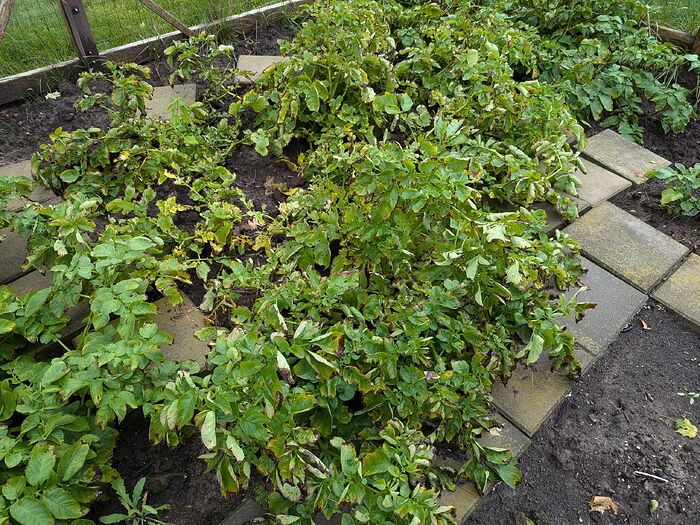They’re beautiful. What variety are they?
Puget Gold. We know zilch about growing apricots, and planted the tree a few years back on a whim. If you had asked us last year, we’d have said the tree is a goner (didn’t look too healthty) and we were looking for a replacement. Lo and behold - this year, apricots!
My upstate garden is lousy with cukes!
I am very happy. Also, a question for @bogman or whomever: The downside of being an every-two-weeks gardener is that you miss peak pole bean and get this:
What would happen if I let the seeds mature? Would I be able to cook them like white beans?
Meanwhile, downstate, at long last peppers! I might actually be able to make a chile relleno casserole this year. Woot!
My potatoes have early blight.
Would you remove them or treat them?
Our first pick of corn this summer!
Quite a surprise, after the coldest spring/summer season here in decades. We had pretty much written off getting any this year. The plants are stunted, not all the plants put on two ears, and pollen was dropping before much of the silk had emerged. We persisted with the hand pollination with what we could, and here they are … right on time, despite nighttime temps still in the 50’s. We won’t get as much as a typical year, but we’re getting something!
One of the few foods in life I’m willing to spend butter-calories on, it’ll all be gone in a week.
![]()
![]()
![]()
![]()
I probably should’ve pulled them, but I have let it go on potatoes. But I grow them in the winter when none of the summer veg is at risk.
Here’s what UC IPM says. Apparently no need to panic!
Thank you!!
Pretty! Is that Listada de Gandia or perhaps the mini Fairy Tale?
That depends upon the variety of bean. Most dry beans are perfectly edible and good. Some may have tougher skins. If you’re growing one variety of common bean, Phaseolus vulgaris, the dry beans can be saved for next year’s planting.
Harvest the yellow or dry pods, the mature beans, to dry indoors, out of the sun for 3-4 weeks, spread in a single layer. A pizza box works well. Once fully dried, put them in an airtight glass jar, labeled with the variety and year. Keep the jar in a fridge and the seeds should last at least four years, often over ten years. Don’t open the jar, when cold; let it sit closed, out in the room, to get to room temperature before opening. This is to prevent “sweating”, moisture condensation.
At this point, you can soak a small amount overnight, or do the quick-soak/cook method and test the eating quality of the dried beans. If it’s not to your liking, use them for planting. I always let some of my beans mature for seed, trying to select from the best, healthiest. Of course, the selected bean plants produce fewer beans because energy is going into the seeds.
That depends on how severe the infestation is. If it’s blotched leaves here and there, I’d remove them promptly, before spores spread. Then, use fungicides, at least two, different types. If the planting is small, it may not be worth buying fungicides. While Daconil (Chlorothalonil) is recommended, it’s widespread availability and use make it ineffective against many strains of blight, early or late. If the planting is large, I’ve used Switch fungicide very successfully. However, we’re talking serious expense with that one. You could also try one of the copper based fungicides, before or after the Daconil. The copper-based ones are usually inexpensive. Some are listed as allowed in organic growing.
Thank you! I’m pretty sure these are either Blue Lake or Kentucky Wonder.
Fairy Tale, if I remember correctly.
Thank you.
It’s not a huge planting. Maybe around 36 plants. They all seem to have a touch of early blight on the leaves. We have had a lot of rain lately.
Another low to the ground tomato, half ripe, got eaten away yesterday. So I went and got a bottle of alleged rabbit repellant (appears to be mostly hot pepper) that you can spray directly on the veg, and I also bagged the only remaining low to the ground tomato (which was fully green) with one of my organza bags. And then I soaked the bag in the repellant .
I did that at 10 pm, in the dark. By this morning, the bagged tomato was also gnawed at, through the bag.
GRRRRRRR
When I hear about or see low tomatoes getting eaten, my first guess is turtles! box turtles around here love tomatoes. They’re often out late, or very early in the morning. I kind of doubt hot pepper bothers them. Look for V-shaped gnaw marks, from their beak.
I’m so glad the garden was minimal this year. We’re still in a terrible drought (since May) , with high temperatures. Weeds are wilting, local corn crops are wasted and the ground is like concrete. So, with this going on, it seemed like a perfect time to grow some of the heat & drought sensitive herbs, Cilantro and Dill. They came up and I’ve already been harvesting!
Indoors, under lights! The view is a bit foggy, since they were just watered. The herbs are temporarily in a 55 gallon glass tank, until I make a proper ornamental terrarium.
Fresh dill is required to make Lithuanian cold, pink soup, šaltibarščiai (shalt-eh-barsh-chay). The bright pink color is a bit startling to those who don’t know it. It’s a fine side dish or light lunch when it’s scorching outside. My mom is Lithuanian, and we grew up with cold, pink soup.
The dill also finds its way with salmon, potato salad, or mixed with yoghurt (or sour cream) to put on potatoes.
That’s awesome! How much humidity is in the tank? Is there an ideal amount?









